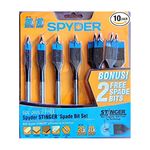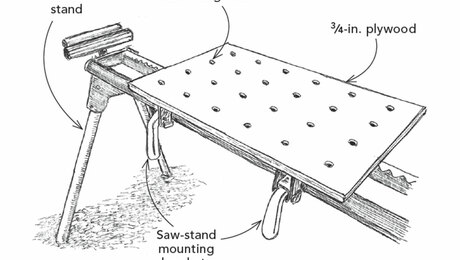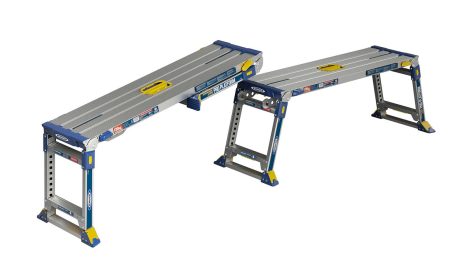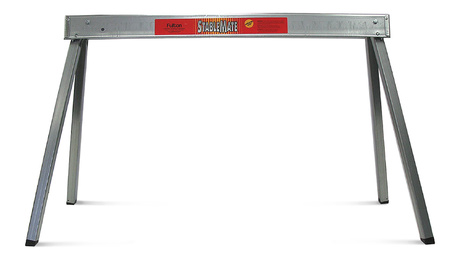More Miter-Saw Stands Reviewed
Comments on seven additional stands reviewed by our testers
Portamate PM7000
• http://www.htcproductsinc.com
• $220
Though large press buttons release the legs for extending or folding, the Portamate is a heavy, bulky system best reserved for your shop or locations where it will be used for an extended period of time.
Cam mounting locks are easy to operate and mount bars slide easily along the rail and lock down in alternate positions.
The stand incorporates multiple accessories, among them a powerstrip; two additional quick-release tables; a vise; and a work support with a gooseneck lamp, which proved helpful on even well-lit sites.
Be aware, their single sliding bolt connection makes work supports wobbly. To avoid snapping them off, don’t handle the stand by the supports and be sure to remove them before lifting the stand on end.
Dewalt DW723
• http://www.dewalt.com
• $219
The Dewalt is probably the most popular rail stand system. Like the Portamate, the cam mounting locks are easy to operate, mount bars slide easily along the rail, and set-up is hassle-free thanks to a large press button that allows you to extend or fold the legs.
The work support extensions have a little flex and the upright supports are small, flat chrome plates which slide work pieces across smoothly.
Hitachi UU610CZ
• http://www.hitachipowertools.com
• $180
For easy set-up, spring-loaded pins tilt to release and lock the legs, but when mounting the saw, it takes practice to orient the plates to the rails and lock them in place.
To aid in mobility, small wheels at one end are somewhat useful to wheel the stand around when legs are folded up, but only on hard, flat surfaces.
Cam lock levers quickly loosen and lock down the support extension arms. The extensions are not only the stiffest among the stands, but they also support heavy pieces without deflecting as much as the other stands we tested.
Stablemate PRO 1000
• http://www.fultoncorp.com
• $160
Though the Stablemate PRO earned high marks for setup and stability, it’s crudely designed with a frame made of square and round steel-tube stock. Each saw bracket has a threaded hand-crank bolt to draw one of the feet against the rail tube, which seems to me, a system that will wear with repeated use.
The work supports, also made of steel tubing, are supported by two threaded rods. To slide the extension tubes in or out, you must adjust pairs of nuts each time, and it can be tricky to get the support tubes level on the threaded rods.
The work stops are spring-loaded plates on the backsides of the support tubes, which I felt were too crude to be worth using.
Craftsman 22302
• http://www.craftsman.com
• $219
If you use the Craftsman stand, you’ve got to do a little work first. The saw mounts atop two wood plates that you must drill through and bolt onto the saw legs. Clamp arms then lock the wood plates to the rail. It’s a simple system but it can be difficult to realign the saw parallel with the stand. This becomes a problem when you need to align the saw with the work supports.
To make the stand compact, it’s hinged in the middle, but the hinge complicates the setup; it takes practice to unlock and unfold the top. It’s also not as mobile as we thought it would be, and despite having handles, it’s bulky and more awkward to carry than many other rail models. Although it comes with snap-on wheels, they’re a wasted feature if you forget where you left them (like we did).
TrojanMS-2000
• http://www.trojantools.com
• $350
With practice, setting up and breaking down the Trojan MS-2000 becomes a dance, but the first few times you do it, it’ll feel more like a wrestling match. The wheels have a tendency to roll away from you, and when upright, the legs can come close enough to the wheels to risk scratching a finished floor. The sequence for folding, extending, and locking the work supports takes a little getting used to as well.
The collapsed body is small, a plus for storage, but without a long handle, it’s hard to bend and pull the wheels up steps. We were generally satisfied with its portability and wide pneumatic tires help navigate it through rough job terrain.
The outrigger work supports have crossbars at 15-in., 30-in, and 58-in. from the blade. This feature makes it easier to support short, medium and long stock.
Rousseau 2950
• http://www.rousseauco.com
• $275
Stout construction makes the Rousseau a very stable workstation. Steel-angle legs are locked in place by scissor brackets which are stiff yet difficult to lock and unlock which can make set up frustrating.
For added stabilization, the stand features separate legs for the work supports and adjustable leveling feet on the wheel side. Be sure to retract the feet before rolling to avoid scratching surfaces.
When folded, the Rousseau is compact and stores easily. It isn’t so easy to move though and there are no handles to aid lifting.
To find out which stands impressed Mike and Rick most, read the article 6 Great Miter-Saw Stands from the August/September 2007 issue of Fine Homebuilding. And to learn more, watch a video where Mike explains the four classes of stands and their benefits.
Fine Homebuilding Recommended Products
Fine Homebuilding receives a commission for items purchased through links on this site, including Amazon Associates and other affiliate advertising programs.

Code Check 10th Edition: An Illustrated Guide to Building a Safe House

Spyder Stinger Spade Bit

Pretty Good House

























